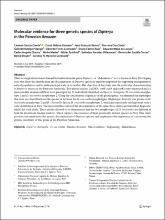Por favor, use este identificador para citar o enlazar este ítem:
https://hdl.handle.net/20.500.12921/418| Título : | Molecular evidence for three genetic species of Dipteryx in the Peruvian Amazon |
| Autor : | García Dávila, Carmen Aldana Gomero, David Renno, Jean-François Díaz Soria, Rossana Hidalgo Pizango, Gabriel Flores Llampazo, Gerardo Castro Ruiz, Diana Mejía de Loayza, Eduardo Angulo Chávez, Carlos Mader, Malte Tysklind, Niklas Paredes Villanueva, Kathelyn Del Castillo Torres, Dennis Degen, Bernd Honorio Coronado, Eurídice |
| Palabras clave : | Dipteryx charapilla Dipteryx micrantha Variación genética Distancia genética Microsatélites Secuencia de ADN Dipteryx Genotipos Loreto Ucayali Madre de Dios Amazonía |
| Fecha de publicación : | dic-2019 |
| Editorial : | Springer Nature |
| Citación : | Genetica (2019): 1-12 Garcia-Davila, C., Aldana Gomero, D., Renno, J. F., Diaz Soria, R., Hidalgo Pizango, G., Flores Llampazo, G., ... & Honorio Coronado, E. N. (2020). Molecular evidence for three genetic species of Dipteryx in the Peruvian Amazon. Genetica, 148, 1-11. |
| Resumen : | There is a high international demand for timber from the genus Dipteryx, or “shihuahuaco” as it is known in Peru. Developing tools that allow the identification and discrimination of Dipteryx species is therefore important for supporting management of natural populations and to underpin legal trade of its timber. The objective of this study was the molecular characterization of Dipteryx species in the Peruvian Amazonia. Two plastid regions (cpDNA: trnH–psbA and matK) were sequenced and 11 microsatellite markers (nDNA) were genotyped for 32 individuals identified as Dipteryx charapilla, D. micrantha morphotype 1 and D. micrantha morphotype 2. Using the concatenated sequences of the plastid genes, we identified ten haplotypes that were not shared between the species or between the D. micrantha morphotypes. Haplotypic diversity was greater in D. micrantha morphotype 2 and D. charapilla than in D. micrantha morphotype 1, which presented only one haplotype with a wide distribution in Peru. The microsatellites allowed the discrimination of the same three clades and identified diagnostic alleles for each clade. These results allowed us to demonstrate that the two morphotypes of D. micrantha are different at both the plastid and nuclear markers, which supports the existence of three genetically distinct species in Peru. This study provides information for the genetic discrimination of Dipteryx species and emphasises the importance of conserving the genetic variability of this genus in the Peruvian Amazonia. |
| URI : | https://hdl.handle.net/20.500.12921/418 https://doi.org/10.1007/s10709-019-00082-2 |
| ISSN : | 1573-6857 |
| Aparece en las colecciones: | Artículos en revistas indexadas |
Ficheros en este ítem:
| Fichero | Descripción | Tamaño | Formato | |
|---|---|---|---|---|
| Garcia_articulo_2019.pdf Until 2039-12-01 | Texto Completo | 1,84 MB | Adobe PDF |  Visualizar/Abrir Request a copy |
Compartir :
Los ítems de DSpace están protegidos por copyright, con todos los derechos reservados, a menos que se indique lo contrario.



